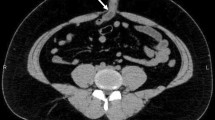Abstract
We discuss a diabetic obese patient with an extensive necrosis of the ascending and transverse colon plus segmental necrosis of the small bowel incarcerated in a massive median incisional hernia below the umbilicus. After a blood test and an abdominal CT scan (without contrast dial), the patient underwent an urgent operation. We performed an extended right hemicolectomy, multiple segmental small bowel resections and a terminal ileostomy. The defect of the abdominal wall was treated with vacuum-assisted closure (VAC) therapy with good results.




Similar content being viewed by others
References
Korenkov M, Paul A, Sauerland S, Neugebauer E, Arndt M, Chevrel JP, Corcione F, Fingerhut A, Flament JB, Kux M, Matzinger A, Myrvold HE, Rath AM, Simmermacher RKJ (2001) Classification and surgical treatment of incisional hernia. Results of an experts’ meeting. Langenbecks Arch Surg 386:65–73
Bucknall TE (1983) Factors influencing wound complications: a clinical and experimental study. Ann R Coll Surg Engl 65:71–78
Diebel L, Saxe J, Dulchavsky S (1992) Effect of intraabdominal pressure on abdominal wall flow. Am Surg 58:573–576
Mutter D, Jamali FR, Moody DL, Rodeheaver GT, Thèrin M, Marescaux J (2000) The concept of protected mesh to minimize adhesion formation in intraperitoneal abdominal wall reinforcement. Preclinical evaluation of a necomposite mesh. Hernia 4(Suppl):S3–S9
Argenta LC, Morykwas MJ (1997) Vacuum-assisted closure: a new method for wound control and treatment: clinical experience. Ann Plast Surg 38:563–577
Morykwas MJ, Argenta LC, Shelton-Brown EI, McGuirt W (1997) Vacuum-assisted closure: a new method for wound control and treatment: animal studies and basic foundation. Ann Plast Surg 38:553–562
DeFranzo AJ, Argenta LC, Marks MW, Molnar JA, David LR, Webb LX, Ward WG, Teasdall RG (2001) The use of vacuum-assisted closure therapy for the treatment of lower-extremity wounds with exposed bone. Plast Reconstr Surg 108:1184–1191
Sposato G, Mloea G, Di Caprio G, Scioli M, La Rusca I, Ziccardi P (2001) Ambulant vacuum assisted closure of skin graft dressing in the lower limbs using a mini VAC device. Br J Plast Surg 54:235–237
Song DH, Wu LC, Lohman RF, Gottlieb LJ, Franczyk M (2003) Vacuum assisted closure for the treatment of sternal wounds: the bridge between debridement and definitive closure. Plast Reconstr Surg 111:92–97
Argenta PA, Rahaman J, Gretz HF III, Nezhat F, Cohen CJ (2002) Vacuum assisted closure in the treatment of complex gynaecology wound failures. Obstet Gynecol 99:497–501
Baynham SA, Kohlman P, Katner HP (1999) Treating stage IV pressure ulcers with negative pressure therapy: a case report. Ostomy Wound Manage 45:28–32
Dersch T, Morykwas M, Clark M, Argenta L (1994) Effects of negative and positive pressure on skin oxygen tension and perfusion. 4th Annual Meeting of Wound Healing Society, San Francisco, 1994. Wound Repair Regen 2:64
Morykwas MJ, Argenta LC (1993) Use of negative pressure to decrease bacterial colonisation in contaminated open wounds. Annual Meeting, Federation of American Societies for Experimental Biology, 1993
Korff T, Augustin HG (1999) Tensional forces in fibrillar extracellular matrices control directional capillary sprouting. J Cell Sci 112:3249–3258
Wysocki AB, Staiano-Coico L, Grinnell F (1993) Wound fluid from chronic leg ulcers contains elevated levels of metalloproteinases MMP-2 and MMP-9. J Invest Dermatol 101:64–68
Moses MA, Marikovsky M, Harper JW, Vogt P, Eriksson M, Klagsbrun M, Langer R (1996) Study of the activity of matrix metalloproteinases and their endogenous inhibitors during wound-healing. J Cell Biochem 60:379–386
Author information
Authors and Affiliations
Corresponding author
Rights and permissions
About this article
Cite this article
Montecamozzo, G., Leopaldi, E., Baratti, C. et al. Incarcerated massive incisional hernia: extensive necrosis of the colon in a very obese patient. Surgical treatment and vacuum-assisted closure therapy: a case report. Hernia 12, 641–643 (2008). https://doi.org/10.1007/s10029-008-0370-4
Received:
Accepted:
Published:
Issue Date:
DOI: https://doi.org/10.1007/s10029-008-0370-4




